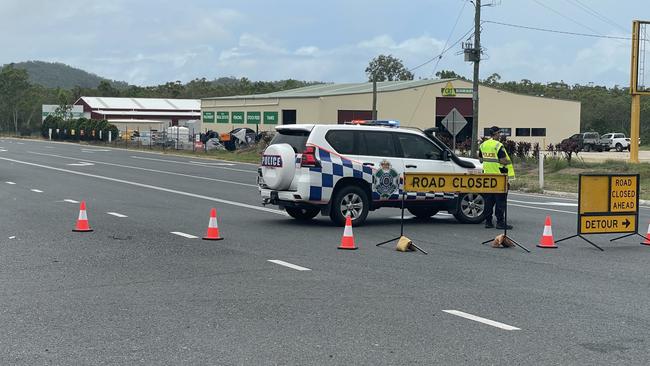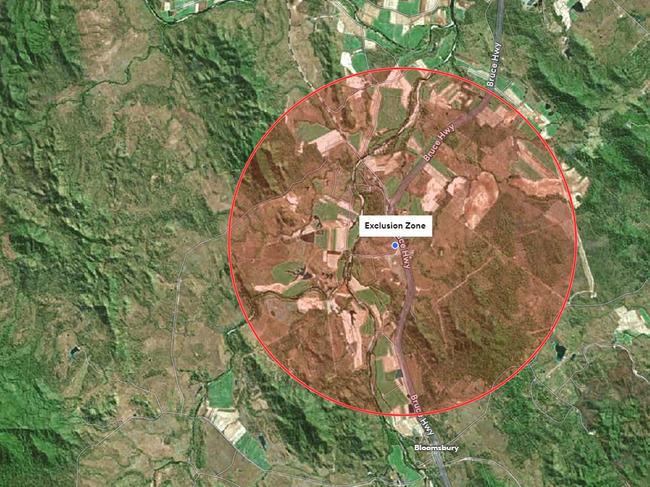Bloomsbury truck crash: Remaining chemical tanks intact, open soon
A truck crash north of Mackay closed a crucial section of the Bruce Highway in both lanes while emergency services clean up tonnes of highly explosive chemicals.

Mackay
Don't miss out on the headlines from Mackay. Followed categories will be added to My News.
A scientific officer at the scene of Tuesday’s chemical spill has said that the public service preservation act declaration can be revoked and traffic will soon resume.
The truck crash, which closed the Bruce Highway both directions near Caping Rd, at midday on Tuesday, spilt chemicals all across the road.
Overnight Police and Queensland Fire and Rescue crews worked to ‘decant’ the truck’s explosive payload.
Decanting is the process of moving a chemical from one container to another and can be extremely dangerous depending on chemical volatility and leaves personnel vulnerable to spills, exposure to vapours and other hazards.
Queensland Rail was forced to stop all trains passing through the area at 4.40am due to the ongoing nature of the threat.
As of 12.30pm, the truck had been rotated and emergency services removing material from the underside of the truck.
Inspections indicate that the remaining tanks are intact and that the truck can be moved from the road shortly.
Trains will resume and soon the highway will be reopened completely.
EARLIER:
Emergency services have set up a 5km exclusion zone on the Bruce Highway north of Mackay after a truck began “leaking a toxic substance” following a crash.
Northbound traffic is being diverted via Midge Point Road, while southbound traffic is being diverted via Koonapippi Road. The Queensland Department of Transport and Main Roads warns only light to medium vehicles can use the diverted routes.
A Queensland Fire and Emergency Services spokesman said four units were called to the scene at Bloomsbury near O’Donnells Rd about 11.30am after a truck, which was towing a trailer, rolled.
The spokesman confirmed the truck was carrying ammonium nitrate, prill and diesel - materials typically for blasting in mines.
He said there was a significant amount of chemicals leaking from the truck but the driver was safely out of the vehicle.
The Queensland Police Service has made an emergency declaration under the Public Safety Preservation Act, stating the truck was “leaking a toxic substance”.
“An exclusion zone was established with a 5km radius,” the QPS has stated.
Police are also evacuating properties along Stafford Rd, Campbells Rd, Caping Rd, and O’Donnells Rd.
“Traffic is being diverted at Kunipipi Road for southbound traffic and Midge Point Road for northbound traffic,” the QPS statement said.
“Motorists are urged to avoid the area or expect significant delays.”

It is understood the truck and trailer which rolled at Bloomsbury was carrying about five tonnes of ammonium nitrate.
A truck driver, who is experienced in transporting the potentially dangerous goods, has explained what would need to happen to ignite the fertiliser to create a replica of the 2014 road train crash which blew up a Queensland bridge and caused about $8m in damages.
That truck was carrying six tonnes of blasting materials.
The driver said the ammonium nitrate was typically stored in two components, with the prill — dry stuff — carried in the truck and the emulsion — wet stuff — in the trailer at the rear.
He said there was about 3mm of aluminium separating the components, which were only carefully mixed as they were dispersed from the truck via a control panel.
The material will not ignite or explode unless it’s got a booster in it, “a full-on detonator … something to get a proper kick”, the truck driver explained.
“You can light up ammonium nitrate prill with a cigarette lighter and it will not blow up unless it’s confined.”
He said the Kalari truck explosion in southern Queensland, which destroyed a bridge on the Mitchell Highway and left the driver with serious injuries, was ignited by the use of foam fire-fighting agents.
“With prill, you can spray it with water and it dissolves, but they (emergency services) used the foam which basically confined it.”
The driver said when the materials were used for blasting in the mines, the ammonium nitrate was packed down a hole and then capped, creating the confined conditions needed for ignition.
The driver, who has himself rolled a truck carrying ammonium nitrate, said the truck at Bloomsbury should be safe from exploding unless the wrong firefighting agent was used, or there was some other trigger for ignition.
He said the dangerous goods trucks had three panels, one on each side and a further at the rear, with information about what was being carried and how to extinguish it, or handle it, in case of an emergency.
He said drivers had to renew their dangerous goods licence every three years which was “pretty full on” including an exam.
“If the people in the truck (at Bloomsbury) were fine (after the crash), they would have told the emergency services what they had on, basically pushed everyone back as far as they could until everyone turned up and sorted it out.”
He said the clean-up of the highway would likely be relatively straightforward and involve using degreaser and or sand.




